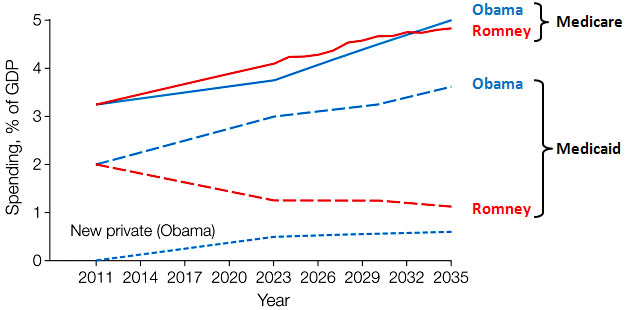
The Journal of the American Medical Association
Barrels of ink have been spilled over Medicare during this year’s campaign. There’s nothing wrong with that: Obama and Romney have fundamentally different approaches to Medicare and they deserve attention. Romney, for example, wants to increase the eligibility age to 67 and convert Medicare into a voucher system that relies primarily on competition between private firms to rein in costs. That’s a big change. At the same time, the actual differences in what the two candidates would spend on Medicare is fairly modest. This is more a fight over means than ends.
The same can’t be said for Medicaid. Romney wants radical changes here too, promising to “block grant” Medicaid if he’s elected. This means the program would be turned over entirely to the states. The federal government would continue to provide a share of funding, but that funding would go straight into state coffers, and states could decide how to spend it. So the question is: Once released from federal regulations, what would states do with their Medicaid money?
Some states would probably try some genuinely interesting experiments, though it’s unlikely we’ll ever discover any magic bullets for reining in health care costs on a state level. But lots of states, especially poor states in the South, don’t have much interest in experimenting. They just want to slash eligibility for Medicaid. Given the freedom to do it, they’d adopt what Ed Kilgore calls the “Mississippi model,” cutting off coverage for a family of three earning anything over $8,200. For all the talk of fresh thinking and new solutions, what they really want to do is simple: They want to stop providing medical care for poor people.
But that’s not all. In this case, there’s more than just differences in ideology at work. Unlike Medicare, which he’s willing to fund at about the same rate as Obama, Romney doesn’t want to spend as much on Medicaid as Obama does. In fact, he wants to take a chainsaw to it. Aaron Carroll and Austin Frakt took a look at the Romney and Obama plans in the Journal of the American Medical Association this week, and the chart above shows their conclusions. On Medicare, the two candidates want to spend roughly similar amounts of money. On Medicaid, Romney wants to spend way, way less. And not just on poor people. As Jon Cohn points out, cuts of this size will have a huge impact on “dual eligibles,” elderly patients who rely on Medicaid to pay their nursing home bills. This is not a minor point of technocratic disagreement. It represents a massive change in our commitment to providing decent medical care for those who can least afford it. Medicaid, much more than Medicare, demonstrates what’s really at stake in November’s election.










